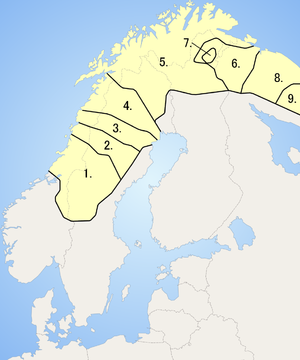Inari Sami language
| Inari Sami (anarâškielâ) | ||
|---|---|---|
|
Spoken in |
Finland | |
| speaker | about 250 | |
| Linguistic classification |
|
|
| Official status | ||
| Official language in | recognized as a minority language in the Finnish municipality of Inari | |
| Language codes | ||
| ISO 639 -1 |
- |
|
| ISO 639 -2 |
smn |
|
| ISO 639-3 |
smn |
|
The Inari Sami language (own name anarâškielâ ) is a language from the eastern group of Sami languages and thus belongs to the Finno-Ugric language family. It is spoken by an estimated 250 Inari seeds in the Inari community in Finnish Lapland . Despite government funding, the language is considered to be extremely endangered because it is hardly passed on to the younger generation.
history
The first books in Inari Sami were the primer Anar Sämi kiela aapis kirje and the Catechism Doctor Martti Lutherus Ucca katkismus, both published in 1859 by Edvard Wilhelm Borg . In 1906 a translation of the Bible was made . After that, literary production largely dried up. In 1986 the Inari Sami Association (Anarâškielâ Servi) was established, which promotes the use of Inari Sami and publishes Inari Sami books, readers, calendars, etc. More recently, hip-hop music has even been written in the Inari Sami language.
In 1992, the Sami in Finland were given the right to use their mother tongue when dealing with authorities in their so-called home area in Northern Lapland. As a result, Inari Sami received an official status in the municipality of Inari alongside Finnish , North Sami and Skolt Sami . Since 1997 there has been an Inari-speaking kindergarten in Inari and Ivalo .
spelling, orthography
Since 1996 there has been a uniform spelling standard for the Inari Sami language. It is written using an expanded version of the Latin alphabet that has the following letters:
A / a, (Â / â), B / b, C / c, Č / č, D / d, Đ / đ, E / e, F / f, G / g, H / h, I / i, J / j, K / k, L / l, M / m, N / n, O / o, P / p, R / r, S / s, Š / š, T / t, U / u, V / v, Y / y, Z / z, Ž / ž, Ä / ä, (Á / á).
The letter Đ stands for the voiced dental fricative [ ð ] (as in English the ) Á is a semi-long [ a ] .
grammar
case
Inarisaic knows nine cases : nominative , genitive , accusative , locative , illative , comitive , abessive , essive and partitive . The genitive and accusative often have the same ending, the partitive is quite unproductive and only occurs in the singular.
Pronouns
The personal pronouns appear in three numbers : singular (singular), dual (two-number) and plural (plural).
| person | Inari Sami | German |
|---|---|---|
| 1. Sg. | mun | I |
| 2nd Sg. | to do | you |
| 3rd Sg. | sun | he she |
| 1. You. | muoi | we both |
| 2. You. | tuoi | you both |
| 3. You. | suoi | they both |
| 1st pl. | mij | we |
| 2nd pl. | tij | her |
| 3rd pl. | sij | she |
verb
The Inarisaic verb is conjugated in three persons and three numbers (singular, dual, plural). It has two simple (past and non-past) and two composite ( Perfect , Past Perfect ) tenses and five modes ( indicative , imperative , conditional , potential and opt ). Like the other Sami languages, Finnish and Estonian , Inari Sami uses a negative verb.
Morphologically, the verbs can be divided into three groups: same-syllable, unequal-syllable and controversial. The gleichsilbigen verbs are the largest group and are equipped with stage change morphologically complex and Diphthongänderungen. In contrast to the other Sami languages, verbs with different syllables have vowel changes in the stem.
literature
- Erkki Itkonen: Inarilappisches Dictionary . Lexica societatis fenno-ugricae: 20. Suomalais-Ugrilainen Seura . Helsinki. ISBN 951-9019-94-4 .
- Pekka Sammallahti, Matti Morottaja: Säämi-suoma sänikirje. Inarinsaamelais-suomalainen sanakirja . Girjegiisá. Ykkösoffset Oy, Vaasa 1993. ISBN 951-8939-27-6 .
- Marja-Liisa Olthuis: Kielâoppâ . [Inari]: Samitigge, 2000.
- Kari Østmo: Sämikielâ vieres kiellân vuáđuškoovlâst . Helsinki: Valtion painatuskeskus, 1988.
Web links
Inari Sami English vocabulary (233 words)
